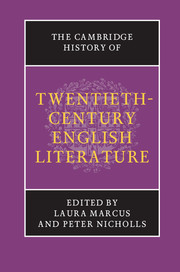Book contents
- Frontmatter
- Introduction
- PART ONE WRITING MODERNITY
- PART TWO THE EMERGING AVANT-GARDE
- PART THREE MODERNISM AND ITS AFTERMATH, 1918–1945
- 10 Trauma and war memory
- 11 The time–mind of the twenties
- 12 Modern life: fiction and satire
- 13 Modernist poetry and poetics
- 14 Modernity and myth
- 15 Psychoanalysis and literature
- 16 Biography and autobiography
- 17 ‘Speed, violence, women, America’: popular fictions
- 18 Theatre and drama between the wars
- 19 Literature and cinema
- 20 The thirties: politics, authority, perspective
- 21 Literary criticism and cultural politics
- 22 Surrealism in England
- 23 World War II: contested Europe
- 24 World War II: the city in ruins
- PART FOUR POST-WAR CULTURES, 1945–1970
- PART FIVE TOWARDS THE MILLENNIUM, 1970–2000
- Bibliography
- Index
- References
17 - ‘Speed, violence, women, America’: popular fictions
from PART THREE - MODERNISM AND ITS AFTERMATH, 1918–1945
Published online by Cambridge University Press: 28 March 2008
- Frontmatter
- Introduction
- PART ONE WRITING MODERNITY
- PART TWO THE EMERGING AVANT-GARDE
- PART THREE MODERNISM AND ITS AFTERMATH, 1918–1945
- 10 Trauma and war memory
- 11 The time–mind of the twenties
- 12 Modern life: fiction and satire
- 13 Modernist poetry and poetics
- 14 Modernity and myth
- 15 Psychoanalysis and literature
- 16 Biography and autobiography
- 17 ‘Speed, violence, women, America’: popular fictions
- 18 Theatre and drama between the wars
- 19 Literature and cinema
- 20 The thirties: politics, authority, perspective
- 21 Literary criticism and cultural politics
- 22 Surrealism in England
- 23 World War II: contested Europe
- 24 World War II: the city in ruins
- PART FOUR POST-WAR CULTURES, 1945–1970
- PART FIVE TOWARDS THE MILLENNIUM, 1970–2000
- Bibliography
- Index
- References
Summary
In a curious incident in The Apes of God (1930), Wyndham Lewis’s compendious satire on modern intellectual and artistic life, two of the central characters engage in a protracted tussle whose pretext is the fate of popular fiction since World War I. Amid the needling and jockeying for position, a thesis, expressed in a vehement tirade, begins to take shape. By the late 1920s the head of every ‘anglo-saxon adult’ had become stuffed with ‘drugged potions, sawed-off shot-guns, arsenic, hairbreadth escapes, blackmail, armed warders, King’s Messengers, pirates and crooks’. ‘From station-stall to smart hotel’, rich and poor alike were reading Edgar Wallace, whereas before and during ‘the Great Massacre’ only the upper class were captivated by such bloodthirsty ripping yarns – and certainly not ‘the young men’ who actually ‘fought the Boche’.
Was this view mere fiction? Lewis evidently did not think so, for only a few years earlier he had advanced a similar claim in The Art of Being Ruled (1926), his little-read political tract urging the ‘segregation of those who decide for the active, the intelligent life’ from the rest. As an inventory of the nation’s reading, Lewis’s argument both registers important truths – the growth of mass literacy, for example, or the uncomfortably close ties between the pre-war spy-thrillers such as those by William Le Queux and debates about national security – while simultaneously simplifying and distorting the structure of the popular-fiction market as a whole. Far from presenting a homogeneous profile, popular literature was becoming increasingly diverse and in many respects rather less conformist than he was ever able to recognise.
- Type
- Chapter
- Information
- The Cambridge History of Twentieth-Century English Literature , pp. 304 - 317Publisher: Cambridge University PressPrint publication year: 2005
References
- 1
- Cited by

